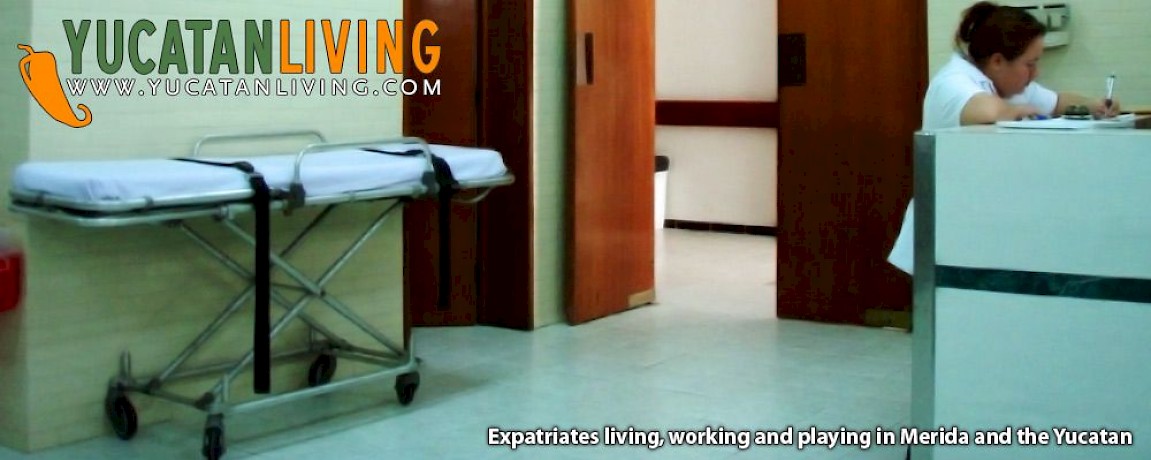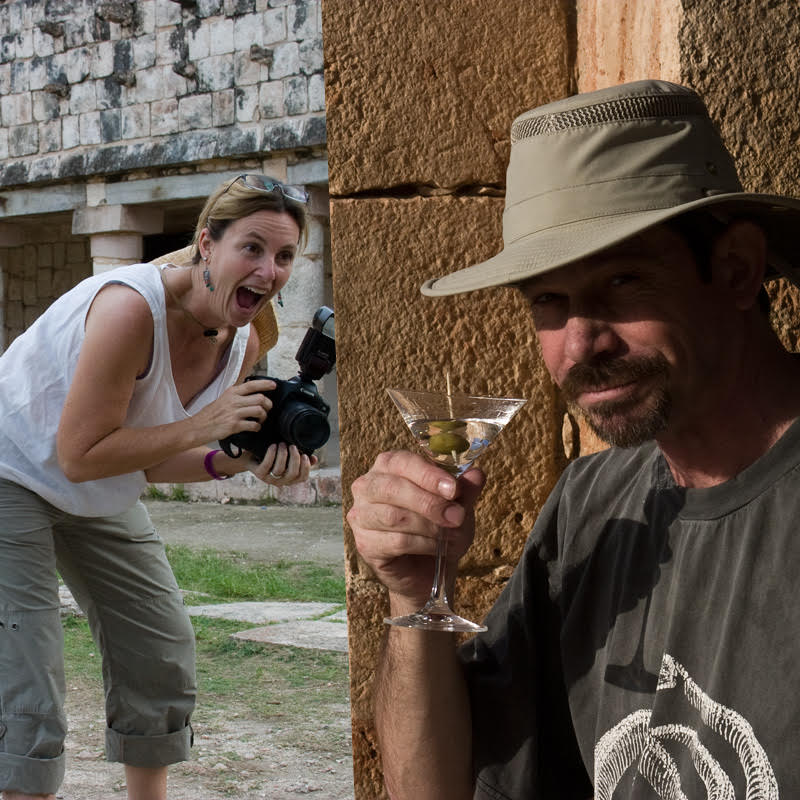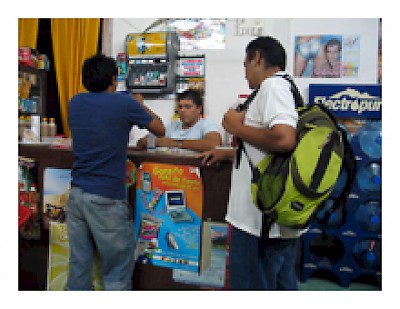Medical Care Merida Style
In the past two days, the Working Gringos have had two medical experiences; one of them was comfortingly similar to experiences we have had in the States, and the other was a bit different. The first was a mammogram. You can probably imagine which one of us went for this procedure. The mammogram took place in a company that specializes in X-rays, CAT scans, ultrasounds, etc. The outfit occupies an old turn-of-the-century building with the de rigeur (around here) pasta tile floors. The small rooms that are traditional in these old houses and line the central corridor are perfect for a series of examining rooms. Inside the rooms, the interior decoration consists of modern imaging equipment mixed with fifty year old chairs and tables, the kind you would see in an old episode of Mayberry R.F.D. if Opie had to go to the doctor.Once inside the room for the mammogram, the procedures and efficiency were pretty much the same. Do this, stand here, lift that arm, wait. Thank you very much. Nothing new or different in that regard, comfortingly modern, all for $850 pesos (about $80 US) paid up front in cash.
A note about health insurance may be of interest here. We pay health insurance to a Mexican corporation called GNP. Our insurance has a high deductible ($3,000 US) and doesn't cover anything preventative (thus the payment for the mammogram). That deductible is for the first $3,000 of any problem that we may have. If we are diagnosed with cancer, a hernia or a broken arm, we pay the first three thousand dollars. After that, GNP pays everything for that problem. Everything. And not only in Mexico. It pays everything anywhere in the world where we may choose to get treatment. For this service, we each pay about $2,200 US a year. So far, we haven't needed this insurance and we hope we never do, but we could someday.
The other medical event happened last night. Arvi (in the blue shirt), the young 18-year old Yucateco who walks our dog URL every afternoon, came home after a particularly rambunctious paseo (walk) with a big gash on his foot. He had apparently run into one of the pieces of iron, which he called a hierro (the word for 'iron'), that just sticks up out of the sidewalk or out of a lawn. His big toe was bleeding and he was in a bit of pain. We sat Arvi down and cleaned the toe, and then we discussed tetanus. He couldn't remember the last time he had had a tetanus shot, so we all decided one was in order. We drove Arvi to one of the big farmacias (pharmacies) down by the central mercado. For $90 pesos, we bought 2 tetanus shots, a syringe, a big bag of cotton balls, a bottle of alcohol and another of hydrogen peroxide (the last two recommended by the pharmacist upon hearing what the problem was). Then we suggested we had to go to a doctor so Arvi could get his injection, but Arvi had another idea.
One of his friends, Javier, is a medic by training, but he is currently running his family's chain of convenience and guayabera stores. Javier was behind the counter at the convenience store at 7:30 PM. Upon hearing the story and examining the contents of Arvi's bag of purchases, Javier loaded up the syringe and brought Arvi into the back room. We waited in the front by the potato chips. A minute later, Arvi emerged with his grin intact and a reminder from Javier to come back in a month for his booster shot. Mucho gustos were exchanged, and we were off.
Another note is perhaps in order here. We Working Gringos got our tetanus boosters this year in our office. A very efficient young lady in a nurse's uniform came by one day and knocked on our office door. She was paid by the IMSS, a Mexican government social services agency, and was going door to door administering tetanus shots to whomever agreed to get them. But, we explained, we are extranjeros (strangers, foreigners). " Ni modo", said she. This program is for everyone. So we dutifully accepted our free tetanus boosters and she went on to the next household.
Now, class, compare and contrast how this experience would have gone down in Central California where we moved from four years ago. Someone cuts their foot. The wound is not too bad so no emergency room services are required, thank goodness. But a tetanus shot is definitely in order. If we go to our regular doctor, we might have to wait a week or two for an appointment. Forgetting whether or not we should even wait that long, the doctor visit would probably cost about $25 (if we have insurance, and a lot more if we don't, as Arvi doesn't) and the shot would be extra. And getting to see someone would take a lot longer. On the other hand, perhaps the conditions are more sterile and the oversight and knowledge of the attending physician, once you get to him or her, will be more thorough. And needless to say, we have *never* had anyone come to our door in California and offer to give us a tetanus shot for free.
So where does this leave us? The jury is out. For routine daily medical problems, we think Mexico provides more than adequate care in an environment that is hassle-free and respects our ability to think for ourselves. Most medicine can be obtained without a prescription. Pharmacists are educated and knowledgeable and act as medical advisors for the people who come to them with minor complaints. Doctors in Mexico, in our experience so far, are well-educated (most of them with some time spent in the US), caring and knowledgeable. If we came down with a major disease or needed special surgery, however, we would probably elect to get treatment back in the US or Europe. (With our policy, we have a choice!).
And in the meantime, we now know where to go if we need someone to administer an injection. And we can even pick up a coke and bag of chips to make it all feel better afterwards.









Comments
sarah fletcher 10 years ago
My husband and I are moving to Merida and I have a chronic pain condition from a motorcycle crash in 2000 and I am wondering if there are doctors there that can keep me on the meds I have been on since the accident? What is the procedure for me there? Thanks
Tawiempls
Reply
Randy 11 years ago
I am in need of surgery. My L5 Disc is sitting on a nerve. I have constant pain and cannot walk too far. I have been dealing with doctors in Canada now for almost 6 months and nothing. I am told I need surgery but I am not even on the list yet. Does anybody know a good back surgeon? Randy
Reply
Working Gringos 11 years ago
Yes, we absolutely can! Call Dr. Arturo Rios, who advertises here on Yucatan Living. He speaks English and works out of the Star Medica Hospital.
Reply
Dub Guimbellot 11 years ago
We reside in the small community of Telchac Pueblo, about 30 miles from Merida. My wife has experienced foot problems for many years. She is one who grows bone spurs under her heals and has been operated on for this issue several times in the states. No matter what the doctors do, the dang things simple grow back and she then has difficulty walking. It's that time again for something to be done with her "spurs". We were looking at going back to the states for surgery, but I'd prefer to get it done here in Yucatan. Can anyone recommend a good doctor of Orthopedic Medicine in the Merida area?
Reply
Martha Wetzel 14 years ago
Hello
My name is Martha; I am Mexican/American citizen and proficiency in English/Spanish. I am a Bilingual Certified Medical Assistant in the US. I am considering going back to Mexico to Merida, Yucatan. I would like to know more about the chances finding a job in a clinic or hospital as an interpreter. I understand there is a big colony of expatriates in that part of Mexico. If somebody has some information please let me know.
Sincerely
Martha
Reply
Working Gringos 14 years ago
You might want to call Dr Fernando Nunez, who speaks perfect English and he has a website at http://www.clinicacolon.com/nunez.html. This is a referral from our article here:
http://www.yucatanliving.com/health/my-medical-experience-in-merida.htm
Good luck!!
Reply
Anonymous 14 years ago
Hello -
I´m writing because I need some serious help assistance.
My husband to be and I are new here.
My husband to be speaks fluent spanish.
I need to be tested for - h py lore.
Im not worried about being embarassed at this point.
I need a stool test to see if I have this disease.
This disease can not be tested with a blood sample.
We can´t seem to find a lab that will do this test partly because we are new to the area and don´t know where to look.
I´m paying out of pocket.
Its important I get this test done before I get very sick.
Can anyone tell me where at least 2 very large medical labs are at in Merida?
And lastly does anyone know where I can locate a gastro-intestinal doctor in Merida?
thank you for any assistance.
Reply
Working Gringos 14 years ago
No, we dont think so. But they do have many English-speaking doctors. You can find a list of some of them here: http://www.yucatanexpatriateservices.com/affiliates
Reply
Surendra 14 years ago
Do Star Medica or the Alta Especialidades have English web sites?
Reply
CasiYucateco 14 years ago
This article was originally written in 2006. Since then, not only is more known about the capacities of Merida's medical communities, but new excellent first class hospitals have been built in Merida, including StarMedica and the hospital of Alta Especialidades that is, I think, part of the IMSS system. (if not, someone will correct me).
At any rate, medical facilities and doctors are first class in Merida, frequently rotating between Houston and Miami (and probably other places) to keep training current. And it should be noted that the doctors at the specialty hospitals are generally the same ones which practice in Clinical Merida and others.
What you get at the specialty hospitals are the equipment for more specific issues and nicer surroundings. Well, more US-style surroundings. Personally, I prefered the CMA hospital room with the singing birds in the courtyard to a closed off AC room, but people differ on these things.
A Meridano friend's young son had Leukemia at age 2. He was treated successfully by the doctors of IMSS and is now 7 with no known issues. Thankfully, that's the closest experience I personally have with cancer treatment in Yucatan, but I do believe they know what they are doing.
There is no better medical treatment in all of SE Mexico than can be found in Merida. If you truly wish to live in Merida, there are competent doctors available for nearly every need. Unfortunately, I don't know the name of an oncologist, but do know are many.
Reply
Linde 14 years ago
P.S.
You say in the article that if you had some major illness, you would probably fly to US or Europe for treatment. My extended family all takes this to mean that I could not find adequate care for followup cancer visits. Do you agree?
Reply
(0 to 11 comments)Next »